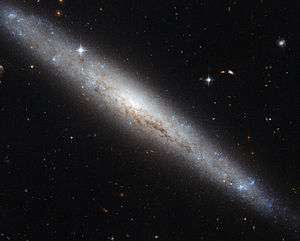NGC 4183
NGC 4183 is a spiral galaxy with a faint core and an open spiral structure located about 55 million light-years from the Sun. Spanning about eighty thousand light-years, it appears in the constellation of Canes Venatici. NGC 4183 was observed for the first time by British astronomer William Herschel on 14 January 1788.
| NGC 4183 | |
|---|---|
 Picture of NGC 4183 created from visible and infrared images taken with the Wide Field Channel of the Advanced Camera for Surveys. | |
| Observation data (J2000 epoch) | |
| Constellation | Canes Venatici[1] |
| Right ascension | 12h 13m 16.860s[2] |
| Declination | +43° 41′ 53.77″[2] |
| Redshift | 0.003105[2] |
| Helio radial velocity | 929 km/s[2] |
| Distance | 55 million light years[1] |
| Group or cluster | Ursa Major Cluster |
| Characteristics | |
| Type | Sc[2] |
| Size | 80,000 ly (diameter) |
| Apparent size (V) | 6.39 x 0.39 |
| Other designations | |
| MCG+07-25-051, UZC J121317.0+434153, [CHM2007] LDC 867 J121316.86+4341537,
FGC 1386, 2MFGC 9620, Z 215-53, LEDA 38988, RFGC 2222, Z 1210.7+4358, 2MASX J12131686+4341537, UGC 7222, [CHM2007] HDC 706 J121316.86+4341537 | |
The galaxy is part of the Ursa Major Cluster.[3]
References
- "Hubble portrays a dusty spiral galaxy". ESA/Hubble Picture of the Week. Retrieved 27 September 2012.
- "Search Results for NGC 4183". Astronomical Database. SIMBAD. Retrieved 27 September 2012.
- "The Ursa Major Groups". www.atlasoftheuniverse.com. Retrieved 2018-01-09.
This article is issued from Wikipedia. The text is licensed under Creative Commons - Attribution - Sharealike. Additional terms may apply for the media files.